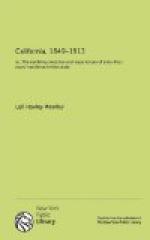On the corner above, Mark Hopkins built his home. At his death it passed into the hands of a Mr. Searles who had married Hopkins’ widow and, not caring to live in California, he had it converted into an art gallery, and the beautiful conservatory into art rooms for the Art Association of the University of California, to whom he bequeathed the property. The building cost in the neighborhood Of $2,750,000.
On the next block, between Mason and Taylor streets, were the Hamilton home, the home of Ex-Mayor E. B. Pond and that of the Tobins. While on the block from Taylor to Jones street stood the A. N. Towne, H. H. Sherwood and George Whittell residences. Just beyond Jones street, on the same side, stood the home of E. J. (Lucky) Baldwin of race horse fame.
In 1861 I moved to 1211 Taylor street, between Clay and Washington, and resided there continuously until 1878, a period of 17 years. And I knew of Stanford, Hopkins, Crocker and Huntington, the quartet of railroad magnates, better than they knew of me. But what shall I say of them? They have all gone beyond the boundaries of human existence and their mansions, together with all the other homes on the hill, were burned in the fire of April 18-21, 1906. They were all men of master minds and are deserving the highest praise for their enterprise, determination and perseverance in the great work they undertook. It was not their money that did it, it was their heads. And there is where the great indebtedness of the State of California comes in to these men.
Going down the eastern slope on California, just below Powell on the south side, at the corner of Prospect Place, stood a house once occupied by Lieut. John Charles Fremont, while on the corner below stood the home of Col. Jonathan D. Stevenson. This building was built in 1851 and had two tiers of verandas that extended entirely around the building. The Colonel died at the age of 94 but had not owned or lived there for many years. It had been converted into a hotel and known as the Harvey House.
Across the street on the other corner stood the Grace Episcopal Church. The Crocker heirs, not desiring to rebuild on their property on California, between Taylor and Jones streets, bequeathed it to the Episcopal Diocese on which to build a new Grace Church. It is now in course of construction.
On Pine street, at the southwest corner of Stockton, stood the Wilson home. On the southeast corner of Mason stood the home of J. D. Oliver, while on the southwest corner stood the home of Mr. Fred McCrellish, the owner of the “Alta California,” while just beyond were the homes of Woods, Jarboe and Harrison and others. On the next block was the old Stow residence while across the street Isaiah W. Lees, chief of police, resided. He was the greatest detective this coast has ever had — his was instinct and intuition, and his records will always remain a lasting monument. On the northwest corner of Jones stood the home of the late James G. Fair, of mining fame, of Nevada.




